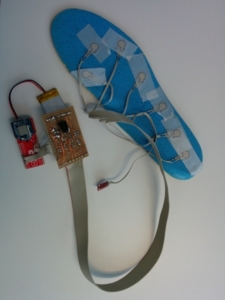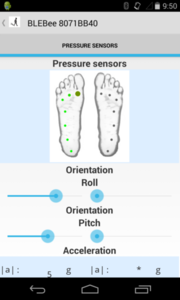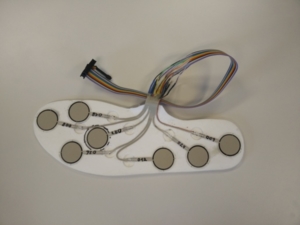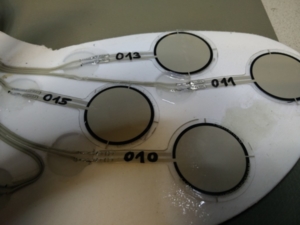The shoe
Introduction
Walking is one of the most fundamental and basic motor skills and provides the foundation for several important human locomotion activities. Inhibitions and impairments to otherwise healthy gait patterns have serious negative consequences. Simple tasks which would otherwise require little or no effort can suddenly become daunting due to the significantly increased effort needed. The diagnosis and treatment of gait disorders is therefore a critical aspect of physical therapy. Accurately investigating and treating underlying gait pathologies, however, typically requires highly sophisticated technology such as three-dimensional motion capture cameras and embedded force plates. These highly accurate technologies are very expensive and require a lot of space meaning they may not be readily available.
Miniature wireless sensing technologies have recently undergone rapid development and become much more affordable and accurate. These technologies have attracted considerable attention among clinical practitioners on account of their applications in affordable and readily-accessible wearable mobile gait analysis systems. In addition to using such systems as portable and low-cost diagnostic instruments, they also show potential for use as portable feedback devices for facilitating motor learning in gait retraining. Current systems are only capable of generating tonal patterns which represent a person’s temporal step frequency, however. Despite the advantages of these systems, representation of a person’s temporal step frequency may be insufficient for optimal gait rehabilitation.
Within both the research and clinical communities, transforming human movement into live sound, known as sonification, has attracted a significant amount of attention as a viable method of altering and rehabilitating movement abnormalities. Sonification systems can provide feedback to users by representing their movements in real-time. The current literature demonstrates the effectiveness of sonification as a means of improving sporting performance and facilitating rehabilitation. Relatively little research has been conducted into the use of sonification for the rehabilitation of abnormal gait patterns, however, despite its considerable potential in this area.
Goals
In response to the demand for affordable gait rehabilitation systems referred to above and the current limitations of wearable mobile gait analysis systems, the SONIGait project, which is part of the CARMA programme, intends to develop a real-time, portable, and low-cost gait sonification application for patient use both inside and outside clinical settings. The SONIGait team’s three principle objectives are therefore to:
- develop a prototype for a pair of wireless, sensor insoles equipped with force-sensors for real-time data transmission and reading by a mobile client (SONIGait)
- present the development of a set of sonification prototypes for auditory feedback on a mobile client in combination with the SONIGait device
- investigate the influence of different sonification tones on spatio-temporal gait parameters
The device
The SONIGait insoles are fitted with 7 A301 force sensors which are directly embedded into the shoe sole. These force sensors are located in the heel area and continue along the lateral part of the sole to the forefoot and metatarsophalangeal joints. This sensor arrangement allows for the calculation of several gait timing parameters as well as the rough approximation of the vertical ground reaction force and plantar force distribution.
The sensor data is transmitted via Bluetooth to an Android smartphone which provides the user with feedback on gait parameters in the form of real-time visual and auditory information relating to the amount of force being applied to specific parts of the insole.
The SONIGait device is powered by a 3.7 V lithium-ion rechargeable battery. Each battery charge provides at least 30 minutes of power.
Methodology
To evaluate the effectiveness of the first SONIGait prototype, we conducted a pilot study with 12 volunteers (six male and six female). We tested how effective the real-time sonification system was at facilitating the alteration of gait patterns using the following experimental procedure.
First we familiarised the participants with the SONIGait device and its intended purpose. Following an initial setup, participants were then asked to walk along a straight eight-metre-long walkway for a total of seven trials. They were asked to walk constantly and at their own pace for all of the trials. This procedure was repeated six times using one of the sonification types described above and once without sonification ¬– in a random order determined by computer program.
Results
The results of our tests revealed that cadence and gait velocity were reduced and step time increased when the participants received sonification feedback compared to when they walked without any feedback. Although counterintuitive, these are promising results with respect to the effectiveness of our SONIGait system. It is important to consider that the participants in our pilot study were healthy individuals with absolutely no gait abnormalities. Bearing this in mind, it is clear that our SONIGait prototype was able to successfully focus participants’ attention on their gait mechanics using sonification feedback.
In patients with abnormal gait mechanics increased focus on their gait may serve as a supplementary means of feedback for learning, in real-time, how they are walking and how they can improve their movements. The goal of this would be for them to improve their walking mechanics by relearning how to walk.
Next steps
The results of our investigations into the first SONIGait prototype show that the method has great potential as an affordable technique for altering gait parameters. The SONIGait team is therefore currently developing a new improved prototype based on the current system.
Our new prototype will be fitted with seven FlexiForce A401 force sensors, as opposed to the seven FlexiForce A301 sensors used in the original prototype. The advantage of the new sensors is that the insole will cover a larger surface area of the shoe and will therefore more accurately capture the associated ground reaction forces acting through each region of the foot. We are also continuously improving the device in terms of miniaturisation and power efficiency to make it practical, affordable and user-friendly.




